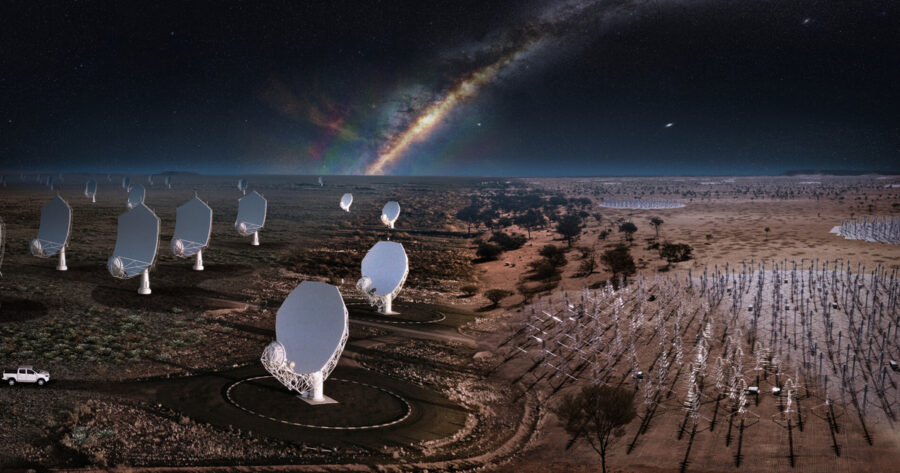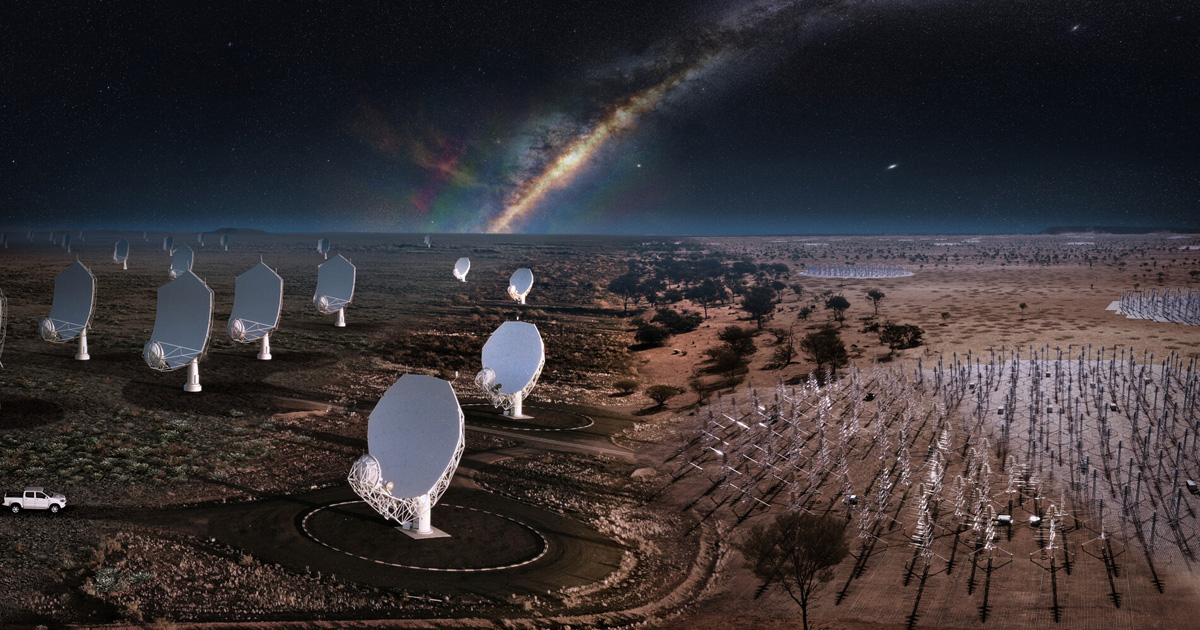
Go-Ahead for World’s Largest Radio Telescope Arrays in South Africa and Australia
The construction of the SKA telescopes – the world’s largest radio telescope arrays – in South Africa and Australia has been given the go-ahead at a historic meeting, it was today announced by the SKA Observatory (SKAO) Global Headquarters in the UK. The approval was given by SKAO’s members states at a meeting of its […]

The construction of the SKA telescopes – the world’s largest radio telescope arrays – in South Africa and Australia has been given the go-ahead at a historic meeting, it was today announced by the SKA Observatory (SKAO) Global Headquarters in the UK.
The approval was given by SKAO’s members states at a meeting of its Council last week. The first phase of construction begins on Thursday 1 July!
The two telescopes, currently called SKA-Low and SKA-Mid (which describes their respective radio frequency range), will be the two largest and most complex networks of radio telescopes ever built, SKAO said in a statement on Tuesday.
humankind is taking another giant leap
“I am ecstatic. This moment has been 30 years in the making,” said SKAO Director-General Prof. Philip Diamond. “Today, humankind is taking another giant leap by committing to build what will be the largest science facility of its kind on the planet; not just one but the two largest and most complex radio telescope networks, designed to unlock some of the most fascinating secrets of our Universe.”
Important facts and figures about SKA
- €2-billion total cost, including €1.3 billion construction (2020 euros) and €0.7 billion for the first 10 years of operations (2021 euros)
- Two telescopes:
o 197 dishes in South Africa, including 64 existing MeerKAT dishes
o 131,072 antennas in Western Australia - 710 PB of science data delivered to science users per year when fully operational
- 7 founding Members of the SKA Observatory, including Australia, China, Italy, the Netherlands, Portugal, South Africa and the United Kingdom
- 9 further countries currently observers in the SKAO Council, including those that took part in the design phase of the SKA telescopes (Canada, France, Germany, India, Spain, Sweden, and Switzerland), and other more recent joiners such as Japan and South Korea
- 500 engineers from 100 institutions across 20 countries involved in the design of the SKA telescopes
- More than 1,000 scientists from 40 countries involved in the development of the science case for the SKA telescopes
- Construction phase: 2021-2029
- Start of construction activities: 1 July 2021
- Start of Observatory and Science commissioning: 2024
- 50+ years of transformational science
There has already been significant engagement between the SKAO’s local partners, the South African Radio Astronomy Observatory (SARAO) and Australia’s Commonwealth Scientific and Industrial Research Organisation (CSIRO), and local communities in preparation for the start of construction.
Memorandums of understanding with Agri-SA and SAN Council of South Africa
In South Africa, SARAO has a memorandum of understanding with Agri-SA, many of whose members own farms which share boundaries with the MeerKAT radio telescope core or will host antennas part of the SKA-Mid telescope in the three spiral arms.
The SKAO says it recognises and acknowledges the Indigenous peoples and cultures that have traditionally lived on the lands on which the SKAO facilities are located.
Dialogue has also been taking place with Indigenous communities, including a Memorandum of Understanding between the San Council of South Africa and SARAO and, just last week, in‑principle support for the project from the Wajarri Yamaji, the traditional owners of the land on which the SKA-Low telescope in Australia will be built.
“The SKAO will be a good neighbour and will work with local stakeholders, and in particular Indigenous communities, to ensure that they also benefit from the SKA project alongside other stakeholders nationally and internationally,” added Prof. Diamond. “We certainly intend to play our part in supporting local communities and boosting the local economy.”
Prof Diamond said:
“I would like to thank everyone who has contributed to making this possible over the past decades, from the early inception of the project until now, and in particular all the teams who have worked so hard over recent years and powered on through a pandemic in very difficult circumstances to meet deadlines and make this milestone possible. I would also like to thank our Member States for their vision and the trust they’re placing in us by investing in a large-scale, long-term research infrastructure at a time when public finances are under intense pressure.”
Dr Catherine Cesarsky, Chairperson of the SKAO Council, said:
“I would like to add my thanks to the members of the SKAO Council and the governments they represent. Giving the green light to start the construction of the SKA telescopes shows their confidence in the professional work that’s been done by the SKAO to get here, with a sound plan that is ready for implementation, and in the bright future of this ground-breaking research facility.”
According to SKAO, in addition to delivering exciting and revolutionary science, the construction of the SKA telescopes will produce societal and economic benefits for countries involved in the project. The well-documented impact, based on SKA-related activities in communities over the last few years, was a key part of the case for the project.
The cost of constructing the two telescopes and the associated operations and business-enabling functions will be €2-billion over the period 2021 – 2030.
Procurement of major contracts for the SKA telescopes will start immediately, with some market surveys having already been conducted in the past few weeks. Over the coming months, some 70 contracts will be placed by the SKAO within its Member States, with competitive bidding taking place within each country.
The first significant activity on site is due to happen early next year, with construction of the telescopes lasting until 2028. The telescopes are planned to have a productive scientific lifetime of 50 years or more.
About the SKAO
The SKAO, formally known as the SKA Observatory, is a global collaboration of Member States, with headquarters in the UK, whose mission is to build and operate cutting-edge radio telescopes to transform our understanding of the Universe, and deliver benefits to society through global collaboration and innovation.
The two telescope arrays will be constructed in Australia and South Africa and be the two most advanced radio telescope networks on Earth. A later expansion is envisioned in both countries and other African partner countries.
SKAO today congratulated its colleagues for this “momentous achievement” and said “we look forward to this new era of discovery!”
✨✨✨ It's a GO for #SKAconstruction! ✨✨✨
The SKAO Council has given the green light: after years of preparation, construction of the world's two largest and most complex radio telescope networks can now start! Read our press release: https://t.co/UygFiIWTgA pic.twitter.com/vBE1T0zR4C
— SKA Observatory (@SKAO) June 29, 2021
